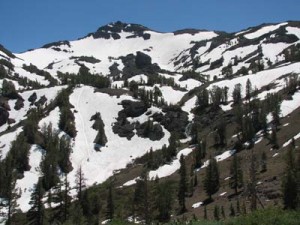Sierra snowpack missing key ingredient: snow

From the back window of my house in North Lake Tahoe the snow looks pathetic. It has receded from full, albeit thin, coverage of the ground to less than half of the backyard. This has not been a good year for snowfall and the resultant snowpack, which will be evaluated again (officially) this week.
Last season (2010-11) was exactly the opposite with more than 600 inches of snow on the ski mountains. In fact, run-off from last year’s snowpack so engorged the reservoirs that they currently remain at healthy levels despite this year’s low precipitation.
How bad is this season? Reno had the lowest recorded snowfall for a December since 1883.
The weak snowpack's latest readings have it at 30 percent of normal, and only 13 percent when measured against season-ending expectations. These numbers will make an impact. After all, the legendary California water wars begin up here in the high country when nature dumps (or fails to dump) its load of snow on the mountaintops.
But there’s more than water at stake in this year’s light snowfall. There’s also the increased potential for fires, which can denude the landscape and leave open hillsides that encourage faster run-off. Quick run-off reduces the amount of water that can be retained for the state’s use. Reports of early preparations by California firefighters have already surfaced, as workers ready planes and other equipment for an early start to fire season.
The economic impact on the ski industry will not be known fully until the end of the season, but it’s clearly been a tough year for the western resorts in general and Lake Tahoe in particular. La Nina weather patterns have pushed winter storms well to the north, and the few low pressure areas that have managed to make their way into the Sierras have provided only minimal moisture. This year, Seattle received unusual amounts of snow while Truckee took in only paltry sums.
Conditions have forced ski resorts to employ an array of snowmaking equipment to provide skiers with a reasonable – if not optimal – experience. But snowmaking, and the water involved, costs the ski industry money that won’t be recouped because of depressed crowds.
“Many ski areas won't reveal how business is going, but the California Ski Industry Association says the Christmas season was down 40 percent statewide,” reported KGO radio out of San Francisco.
Tahoe has been known for occasional “miracle March” snowfalls, and it will take a near record performance to make up for the missing moisture of 2012. Here’s how it’s being reported by the Tahoe Weather Discussion website – one of the most reliable in the area:
“The forecast models are showing now with increased chances of some bigger storms making it into CA for the end of the month and into the first week of March. The snow needs to hurry up because we are getting close to going below the driest season of 76-77 for snowpack.”
Clearly, we’ve hit a rough patch here in Lake Tahoe, and the results for California’s agricultural industry are bound to be negative. Then again, when you combine last year’s epic snow season with this year’s paltry one, you kind of come out even.




